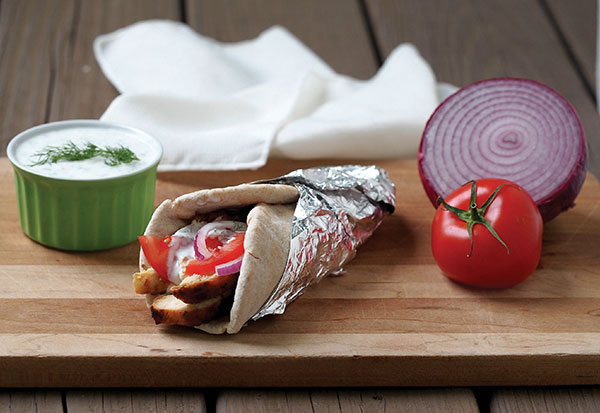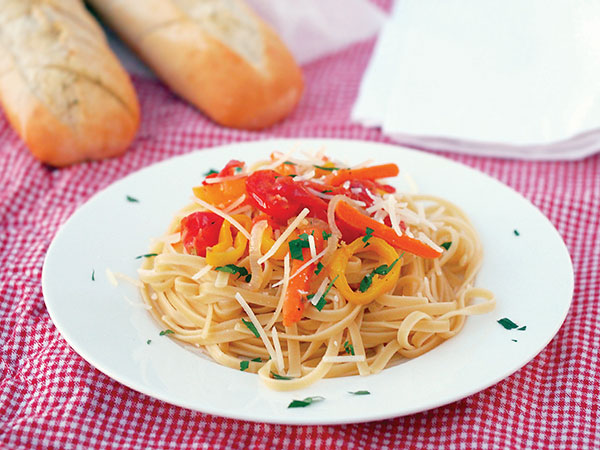Lifestyle
A Mission for Nutrition
Setting out on a mission to eat healthier starts with creating goals and working to achieve them with those you love. To help make nutritious eating more manageable, call together your family and work with one another to create a menu everyone can enjoy while staying on track.
Last Updated on July 17, 2024 by Daily News Staff
Accomplish health goals with better-for-you family meals
(Family Features) Setting out on a mission to eat healthier starts with creating goals and working to achieve them with those you love. To help make nutritious eating more manageable, call together your family and work with one another to create a menu everyone can enjoy while staying on track.
Connecting an array of recipes that all can agree on starts with versatile ingredients like dairy. Gathering at the table with your loved ones while enjoying delicious, nutritious recipes featuring yogurt, cheese and milk can nourish both body and soul.
For example, the key dairy ingredients in these recipes from Milk Means More provide essential nutrients for a healthy diet. The cheese varieties in Feta Roasted Salmon and Tomatoes and 15-Minute Weeknight Pasta provide vitamin B12 for healthy brain and nerve cell development and are a good source of calcium and protein, which are important for building and maintaining healthy bones. Meanwhile, the homemade yogurt sauce served alongside these Grilled Chicken Gyros provides protein and zinc.
To find more nutritious meal ideas to fuel your family’s health goals, visit MilkMeansMore.org.
Feta Roasted Salmon and Tomatoes
Recipe courtesy of Marcia Stanley, MS, RDN, Culinary Dietitian, on behalf of Milk Means More
Prep time: 15 minutes
Cook time: 15 minutes
Servings: 4
- Nonstick cooking spray
- 3 cups halved cherry tomatoes
- 2 teaspoons olive oil
- 1 teaspoon minced garlic
- 1/2 teaspoon dried oregano or dried dill weed
- 1/4 teaspoon salt
- 1/2 teaspoon coarsely ground black pepper, divided
- 1 1/2 pounds salmon or halibut fillets, cut into four serving-size pieces
- 1 cup (4 ounces) crumbled feta cheese
- Preheat oven to 425 F. Line 18-by-13-by-1-inch baking pan with foil. Lightly spray foil with nonstick cooking spray. Set aside.
- In medium bowl, toss tomatoes, olive oil, garlic, oregano or dill weed, salt and 1/4 teaspoon pepper.
- Place fish pieces, skin side down, on one side of prepared pan. Sprinkle with remaining pepper. Lightly press feta cheese on top of fish. Pour tomato mixture on other side of prepared pan. Bake, uncovered, 12-15 minutes, or until fish flakes easily with fork.
- Place salmon on serving plates. Spoon tomato mixture over top.

Grilled Chicken Gyros
Recipe courtesy of Kirsten Kubert of “Comfortably Domestic” on behalf of Milk Means More
Prep time: 30 minutes, plus 30 minutes chill time
Cook time: 20 minutes
Servings: 8
Chicken:
- 3 tablespoons unsalted butter, melted
- 2 tablespoons chopped fresh dill
- 1 tablespoon chopped fresh oregano
- 2 cloves garlic, peeled and minced
- 3 tablespoons freshly squeezed lemon juice
- 1 teaspoon kosher salt
- 1/2 teaspoon black pepper
- 2 pounds boneless, skinless chicken breasts
Yogurt Sauce:
- 1 1/2 cups plain, whole-milk yogurt
- 1 1/2 tablespoons freshly squeezed lemon juice
- 1/2 cup diced cucumber
- 2 tablespoons chopped fresh dill
- 1 clove garlic, peeled and minced
- 1/4 teaspoon kosher salt
- 1/8 teaspoon black pepper
- 3-4 small loaves whole-wheat pita bread, halved lengthwise
- 1 cup thinly sliced tomatoes
- 1/2 cup thinly sliced red onion
- To make chicken: Place melted butter, dill, oregano, garlic, lemon juice, salt and pepper in gallon-size zip-top freezer bag. Seal bag and shake contents to combine. Add chicken. Seal bag, pressing air out of bag. Shake chicken to coat with marinade. Refrigerate chicken in marinade 30 minutes.
- To make yogurt sauce: Stir yogurt, lemon juice, diced cucumber, dill, garlic, salt and pepper. Cover sauce and refrigerate.
- Heat grill to medium heat.
- Grill chicken over direct heat, about 10 minutes per side, until cooked through. Transfer chicken to cutting board and rest 10 minutes. Thinly slice chicken across grain.
- Serve chicken on pita bread with tomatoes, red onion and yogurt sauce.

15-Minute Weeknight Pasta
Recipe courtesy of Kirsten Kubert of “Comfortably Domestic” on behalf of Milk Means More
Prep time: 5 minutes
Cook time: 10 minutes
Servings: 6
- 6 quarts water
- 16 ounces linguine or penne pasta
- 2 tablespoons unsalted butter
- 1/2 cup thinly sliced onion
- 1 cup thinly sliced carrots
- 1 cup thinly sliced sweet bell pepper
- 1/2 cup grape tomatoes, halved
- 1 teaspoon kosher salt
- 1/4 teaspoon black pepper
- 2 cloves garlic, peeled and minced
- 1 cup reserved pasta water
- 1 teaspoon finely grated lemon zest
- 1/2 cup smoked provolone cheese, shredded
- 1/4 cup chopped fresh parsley (optional)
- Parmesan cheese (optional)
- Bring water to rolling boil and prepare pasta according to package directions for al dente texture, reserving 1 cup pasta water.
- In large skillet over medium heat, melt butter. Stir in onions, carrots and sweet bell peppers. Saute vegetables about 5 minutes, or until they brighten in color and begin to soften. Add tomatoes, salt, pepper and garlic. Cook and stir 1 minute to allow tomatoes to release juices.
- Pour reserved pasta water into skillet, stirring well. Bring sauce to boil. Reduce heat to medium-low and simmer 3 minutes. Taste sauce and adjust seasonings, as desired.
- Transfer drained pasta to skillet along with lemon zest and smoked provolone cheese, tossing well to coat. Serve immediately with fresh parsley and Parmesan cheese, if desired.
SOURCE:
United Dairy Industry of Michigan
At our core, we at STM Daily News, strive to keep you informed and inspired with the freshest content on all things food and beverage. From mouthwatering recipes to intriguing articles, we’re here to satisfy your appetite for culinary knowledge.
Visit our Food & Drink section to get the latest on Foodie News and recipes, offering a delightful blend of culinary inspiration and gastronomic trends to elevate your dining experience.
https://stmdailynews.com/category/food-and-beverage
You can also find food and beverage-related videos on our YouTube channel, where we regularly post new content and share tips, recipes, and demonstrations. https://youtube.com/playlist?list=PLEhXBupt8tVynuUhpQZMxQt4lvPmOiAtQ&si=InDwc7YaB0KIwmxy
Discover more from Daily News
Subscribe to get the latest posts sent to your email.
Stories of Change
The Holiday Spirit Matters But So Does What Happens After
The Holiday Spirit: Holiday generosity is powerful, but community needs don’t end when the decorations come down. Learn practical ways to give back year round—volunteering, donating, sharing skills, and supporting causes you believe in—with help from United Way.

The Holiday Spirit Matters — Why Giving Back Should Last All Year
(Family Features) During the holiday season, many people feel a renewed sense of generosity. It’s a time when communities come alive with food drives, toy collections, volunteer events and donation campaigns – all fueled by the spirit of giving. While this seasonal energy can be powerful, the need it responds to doesn’t fade when the decorations come down. Giving back is not only essential during the holidays; it’s also the foundation of stronger, more resilient communities year round. People in nearly every community face challenges – whether it’s affording holiday presents or meeting basic needs like food, rent and utilities. For many families, current economic strains are forcing them to make tough decisions like sacrificing necessities or depleting savings to create moments of holiday joy. This is a time to rally support and help neighbors in need. Right now, many community members who didn’t previously need help are seeking support. Acts of generosity large and small help close gaps and strengthen communities. When individuals and businesses give their time, resources and talent, they can help ensure everyone has a fair chance to not only survive but thrive. Communities rely on nonprofit organizations like United Way – one of the oldest and largest organizations committed to tackling local challenges and mobilizing communities to improve lives. With a presence in nearly 99% of communities across the U.S., the organization recognizes the power of giving and relies on seasonal and year-round generosity to deliver food and housing assistance, youth programs, mental health support, disaster recovery and more. This holiday season and beyond, to assist your community consider taking actions such as: Volunteering Offering your time is one way to make a real change in your community while helping build a more resilient future for all. What’s more, research shows the personal benefits of volunteering, such as reduced feelings of isolation, loneliness and risk of depression. Whether it’s a community event, ongoing support or in-person activities, making a difference for others feels good. Donating Sharing your financial resources can play a vital role in helping communities thrive. Your donation can help put food on the table for families in need, support kids who are struggling or provide mental health services to the most vulnerable individuals. Remember, your gift of any size combines with the gifts of others and builds stronger, more resilient communities. Sharing Expertise or Talent Generosity can take many forms. Making a difference isn’t just about time and money; it can also mean sharing skills or knowledge, and even social networks to bolster charitable efforts. Giving back builds a shared sense of responsibility. It reminds people that strong communities don’t happen by accident – they’re created through connection, compassion and collective action. Supporting Causes You Believe In Every community faces their own unique, pressing challenges and almost everyone has a cause that’s close to their hearts. Identify organizations working to advance those causes and make a plan to support them. Find opportunities to support your community this holiday season and make generosity a year-round tradition at unitedway.org/local.
This is a time to rally support and help neighbors in need. Right now, many community members who didn’t previously need help are seeking support. Acts of generosity large and small help close gaps and strengthen communities. When individuals and businesses give their time, resources and talent, they can help ensure everyone has a fair chance to not only survive but thrive. Communities rely on nonprofit organizations like United Way – one of the oldest and largest organizations committed to tackling local challenges and mobilizing communities to improve lives. With a presence in nearly 99% of communities across the U.S., the organization recognizes the power of giving and relies on seasonal and year-round generosity to deliver food and housing assistance, youth programs, mental health support, disaster recovery and more. This holiday season and beyond, to assist your community consider taking actions such as: Volunteering Offering your time is one way to make a real change in your community while helping build a more resilient future for all. What’s more, research shows the personal benefits of volunteering, such as reduced feelings of isolation, loneliness and risk of depression. Whether it’s a community event, ongoing support or in-person activities, making a difference for others feels good. Donating Sharing your financial resources can play a vital role in helping communities thrive. Your donation can help put food on the table for families in need, support kids who are struggling or provide mental health services to the most vulnerable individuals. Remember, your gift of any size combines with the gifts of others and builds stronger, more resilient communities. Sharing Expertise or Talent Generosity can take many forms. Making a difference isn’t just about time and money; it can also mean sharing skills or knowledge, and even social networks to bolster charitable efforts. Giving back builds a shared sense of responsibility. It reminds people that strong communities don’t happen by accident – they’re created through connection, compassion and collective action. Supporting Causes You Believe In Every community faces their own unique, pressing challenges and almost everyone has a cause that’s close to their hearts. Identify organizations working to advance those causes and make a plan to support them. Find opportunities to support your community this holiday season and make generosity a year-round tradition at unitedway.org/local. Nourishing Our Heroes: Eight Years of Impact at Phoenix VA’s Veggies for VeteransLink: https://stmdailynews.com/nourishing-our-heroes-eight-years-of-impact-at-phoenix-vas-veggies-for-veterans/
Stories of Change: People Making a Difference
Discover inspiring stories of changemakers making a positive impact. Explore videos and articles of people tackling today’s biggest challenges with action and hope. Visit: https://stmdailynews.com/stories-of-change/
STM Daily News is a multifaceted podcast that explores a wide range of topics, from life and consumer issues to the latest in food and beverage trends. Our discussions dive into the realms of science, covering everything from space and Earth to nature, artificial intelligence, and astronomy. We also celebrate the amateur sports scene, highlighting local athletes and events, including our special segment on senior Pickleball, where we report on the latest happenings in this exciting community. With our diverse content, STM Daily News aims to inform, entertain, and engage listeners, providing a comprehensive look at the issues that matter most in our daily lives. https://stories-this-moment.castos.com/
Discover more from Daily News
Subscribe to get the latest posts sent to your email.
Last Updated on December 18, 2025 by Daily News Staff

Keeping Pets Safe This Holiday Season: 5 Festive Safety Tips for Pet Owners
(Family Features) The holiday season brings sparkling lights, cherished traditions and joyful gatherings with the people and pets you love most. As you deck the halls and prepare for cozy celebrations, it’s important to remember some of the magic of the season can also pose risks for curious cats and dogs. To provide pet owners added peace of mind, consider these tips from the experts at VCA Animal Hospitals, a leader in veterinary care with more than 1,000 locations dedicated to positively impacting pets, people and the communities they serve, to keep the holidays merry – and safe – for everyone. Decorations and Festive Outfits From family photos to holiday cards, many pet owners love including their companions in the festivities. If you dress your pet for pictures, choose outfits that are comfortable, allow easy movement and don’t interfere with breathing or vision. Pets are naturally drawn to shiny and dangling decor, so opt for shatterproof ornaments and avoid using tinsel, which can cause serious internal issues if swallowed. Hang small or salt-dough ornaments high on the tree, out of paws’ reach, to help prevent choking. After opening gifts, promptly discard wrapping paper, string and ribbon; items that may seem fun to play with but can be dangerous if ingested. Food and Drinks Holiday tables overflow with delicious treats, but many seasonal foods can be harmful to pets. Chocolate, grapes, raisins, xylitol-sweetened candies and leftover meat scraps may lead to serious illness. Politely remind guests not to slip your pet any treats, no matter how festive the occasion feels. Quickly pack away food when meals end to help reduce temptation. Alcoholic beverages should also be kept well out of reach. Pets absorb alcohol much faster than humans, and even small amounts can cause alcohol poisoning. Candles and Burns The glow of candles and warm fireplaces add comfort and charm this time of year, but open flames pose fire risks and burn hazards for pets. Keep pets at a safe distance from fireplaces, wood stoves and space heaters, as curiosity can bring them too close. Consider using battery-operated candles in place of traditional ones. If you use real candles, ensure they’re placed out of reach and never left unattended; even stepping away for a moment can increase the risk of accidents. Plants and Trees Holiday greenery brings beauty to your home, but some plants require extra caution around pets. While Christmas trees themselves are generally non-toxic, the water in the tree stand may contain mold, bacteria or fertilizers. Use a tree skirt or cover to prevent pets from drinking from it. Decorative plants like poinsettias, mistletoe, lilies, holly and amaryllis can cause gastrointestinal upset if nibbled on. Keep these seasonal favorites well out of reach, especially if you live with adventurous or plant-curious pets. Cold Weather Walking Winter walks can be refreshing for you and your dog, but shorter days and colder weather mean extra care is needed. Use a non-retractable leash during early morning or evening walks, and ensure both you and your pet wear high-visibility gear so drivers and others can easily spot you.
If you live in an area with snow or ice, monitor conditions closely and watch the wind chill. Dressing your dog in a warm sweater or jacket and offering booties for paw protection can help them stay comfortable and safe on frosty outings. By taking a few thoughtful precautions, you can help ensure your pets enjoy a safe, joyful holiday season right alongside the rest of the family. If you have questions about winter safety or your pet’s health, consult your veterinarian. For more tips to keep your pet safe this holiday season, and to find a location near you, visit vcaholiday.com. Photos courtesy of Shutterstock
Food and Drinks Holiday tables overflow with delicious treats, but many seasonal foods can be harmful to pets. Chocolate, grapes, raisins, xylitol-sweetened candies and leftover meat scraps may lead to serious illness. Politely remind guests not to slip your pet any treats, no matter how festive the occasion feels. Quickly pack away food when meals end to help reduce temptation. Alcoholic beverages should also be kept well out of reach. Pets absorb alcohol much faster than humans, and even small amounts can cause alcohol poisoning. Candles and Burns The glow of candles and warm fireplaces add comfort and charm this time of year, but open flames pose fire risks and burn hazards for pets. Keep pets at a safe distance from fireplaces, wood stoves and space heaters, as curiosity can bring them too close. Consider using battery-operated candles in place of traditional ones. If you use real candles, ensure they’re placed out of reach and never left unattended; even stepping away for a moment can increase the risk of accidents. Plants and Trees Holiday greenery brings beauty to your home, but some plants require extra caution around pets. While Christmas trees themselves are generally non-toxic, the water in the tree stand may contain mold, bacteria or fertilizers. Use a tree skirt or cover to prevent pets from drinking from it. Decorative plants like poinsettias, mistletoe, lilies, holly and amaryllis can cause gastrointestinal upset if nibbled on. Keep these seasonal favorites well out of reach, especially if you live with adventurous or plant-curious pets. Cold Weather Walking Winter walks can be refreshing for you and your dog, but shorter days and colder weather mean extra care is needed. Use a non-retractable leash during early morning or evening walks, and ensure both you and your pet wear high-visibility gear so drivers and others can easily spot you.
If you live in an area with snow or ice, monitor conditions closely and watch the wind chill. Dressing your dog in a warm sweater or jacket and offering booties for paw protection can help them stay comfortable and safe on frosty outings. By taking a few thoughtful precautions, you can help ensure your pets enjoy a safe, joyful holiday season right alongside the rest of the family. If you have questions about winter safety or your pet’s health, consult your veterinarian. For more tips to keep your pet safe this holiday season, and to find a location near you, visit vcaholiday.com. Photos courtesy of Shutterstock Keeping Pets Safe This Holiday Season: 5 Festive Safety Tips for Pet Owners
SOURCE: VCA Animal HospitalsThe fate of Lucky Supermarkets in SoCalLink: https://stmdailynews.com/the-fate-of-lucky-supermarkets-in-socal/
Discover more from Daily News
Subscribe to get the latest posts sent to your email.
Family
5 Tips to Pull Off Holiday Hosting
With stay-at-home holidays a thing of the past for many families, they’re now busy preparing for full-blown celebrations. The return of traditional festivities brings seemingly never-ending to-do lists and pressure to be the perfect host.
Last Updated on December 17, 2025 by Daily News Staff
(Family Features) With stay-at-home holidays a thing of the past for many families, they’re now busy preparing for full-blown celebrations. The return of traditional festivities brings seemingly never-ending to-do lists and pressure to be the perfect host.
From mastering a mouthwatering menu and donning your home with decadent decor to ensuring guests enjoy the evening to the fullest, hosting duties bring plenty of responsibilities. This year, though, you can avoid those anxious feelings with some preparation ahead of the big day.
To help pull off a sensational seasonal soiree, consider these tips from the entertaining experts at Sun-Maid to make the holidays brighter and more manageable so you can navigate the stresses of hosting.
Invite Others to Share Favorite Traditions
Especially with stay-at-home holidays in recent years, some friends and family members may have developed their own special traditions from new recipes and foods to seasonal games and activities. Inviting your guests to bring or share something that represents their favorite part of the holidays can help everyone feel welcome.
Take Time for Yourself
Remember to make time for yourself so you can enjoy the fruits of your labor right alongside guests. The busyness of this time of year can add stress but reflecting on the true meaning of the season and reveling in your favorite parts of the holidays can help you avoid feeling overwhelmed.
Add New Ingredients to Your Menu
While pairing this year’s turkey or ham with the classics provides comfort and calls to mind holiday memories of the past, cooking with new ingredients and adding fresh recipes to the menu can put a fun spin on the season and maybe even create your own traditions to carry forward.
For example, baking with an option like Sun-Maid Raisins provides a whole fruit option with zero grams of added sugars per 1/4-cup serving. They’re an easy, better-for-you substitution to reduce overall sugar intake without compromising flavor or texture when compared with dried cranberries, which contain 27 grams of added sugars per 1/4-cup serving. The natural sugars of raisins make them a versatile, useful addition to a wide variety of holiday-worthy dishes.
Hop On Hot Food Trends
One of this year’s most popular trends in the kitchen is food boards, a fun and easy way to elevate flavor while incorporating favorites like cured meats, cold cuts, cheese slices and cubes, dips, nuts and more. Plus, you can keep your board balanced with nutritious items like vegetables and fruit, such as raisins, which provide sweet flavor without the added sugars.
A Time for Truce
Gathering for the holidays is about coming together with loved ones, family, friends and neighbors – and pulling it off means catering to everyone’s needs and wants. It’s a time for compromises and truces. To help add a little extra spark this year, try incorporating a theme to the party or coordinate fun activities and games that can be enjoyed by all. For example, holiday-themed charades, a seasonal “name that tune” game and gift exchanges all give guests ways to get in on the excitement.
To find more holiday entertaining inspiration and recipe ideas, visit SunMaid.com/PullOffTheHolidays .
Photos courtesy of Getty Images
SOURCE:
Sun-Maid Raisins
Discover more from Daily News
Subscribe to get the latest posts sent to your email.

